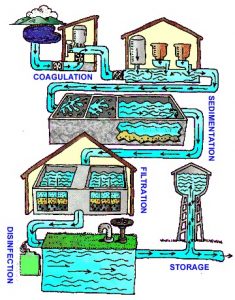Steps in the Water Treatment Process
 We can do without internet access or even electricity. But no community can do without potable water. Drinking or cooking with contaminated water can lead to illnesses such as cholera and dysentery.
We can do without internet access or even electricity. But no community can do without potable water. Drinking or cooking with contaminated water can lead to illnesses such as cholera and dysentery.
Water treatment is done to remove contaminants including bacteria, heavy metals and particulate matter.
Common water treatment steps are outlined below.
Water Treatment Steps
-
Coagulation and flocculation
Particulates in water carry the same charge, leading to repulsion and preventing them from combining with each other. Electrolytes can be added to water, and the ions combine with charged particles, neutralizing their charges. The neutral particles combine to form larger particles, i.e. they coagulate, and settle.
In flocculation, alum, Al3(SO4)3.12H2O, and lime, Ca(OH)2, are added to the water to neutralize particulates. They releae hydroxide ions, causing the water to become more basic. Al(OH)3, Fe(OH)2 and Fe(OH)3 precipitate out of water. As the precipitate sinks, it takes the floating particulates with it, clearing the water.
-
Sedimentation
After flocculated or coagulation, the particles are allowed to settle to the bottom of the tank. Settling tanks should be big enough and flow rates low enough to allow for residence times of at least 4 hours. The settled particulate is called sludge.
-
Filtration
Solid particles are removed using porous media. Filters are often made of sand, gravel or charcoal. Gravity is often used to move water through the filter.
-
Disinfection
Coagulation and sedimentation do not remove all viruses and bacteria. In the disinfection stage, chlorine is added to the water to kill living.
-
pH Adjustment
NaOH is added to treated to water to adjust pH. This reduces corrosion of pipes that the water will flow through.
Sources:
- http://www.cdc.gov/healthywater/drinking/public/water_treatment.html
- http://www.eweb.org/watertreatment
- http://www.science.uwaterloo.ca/~cchieh/cact/applychem/watertreatment.html